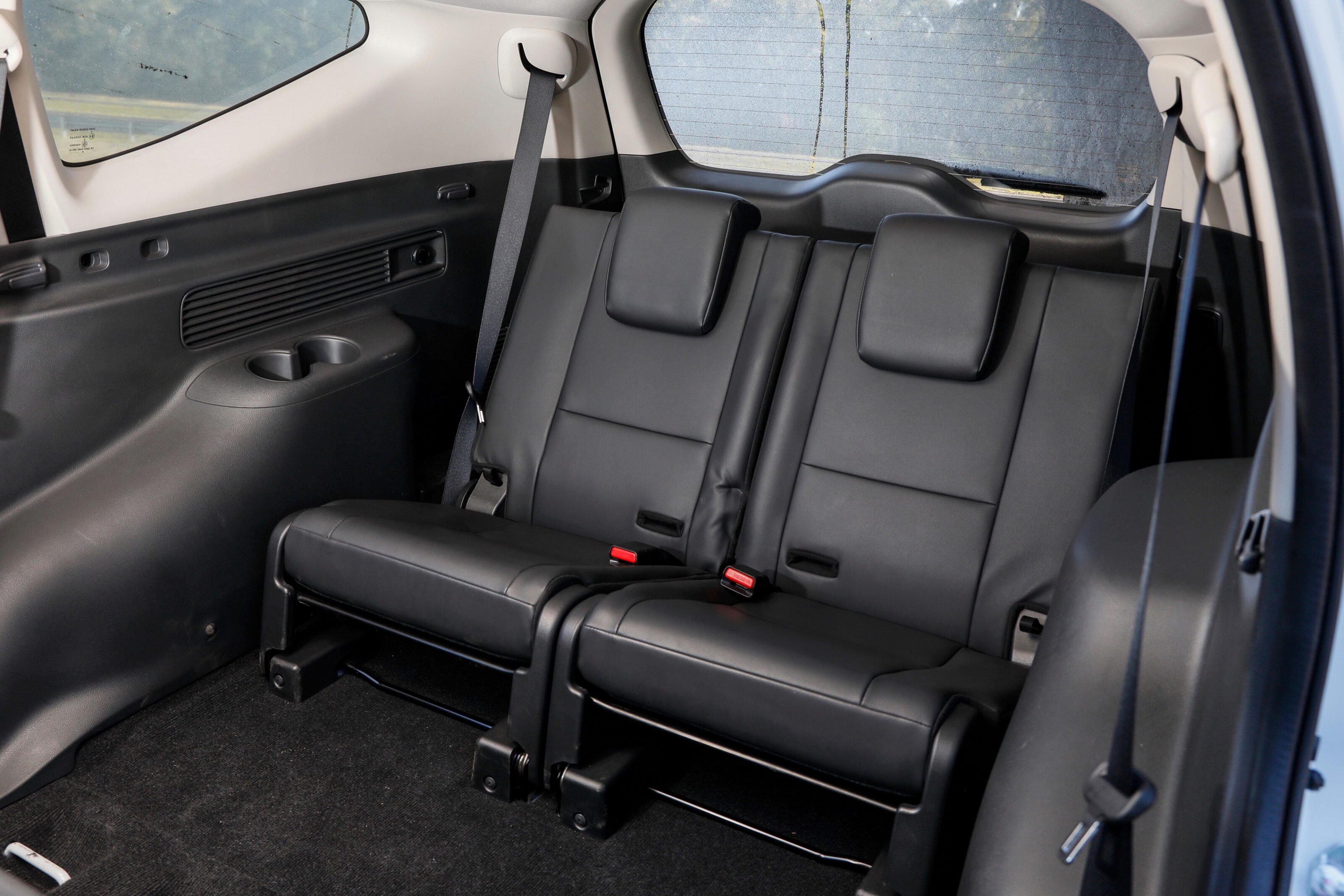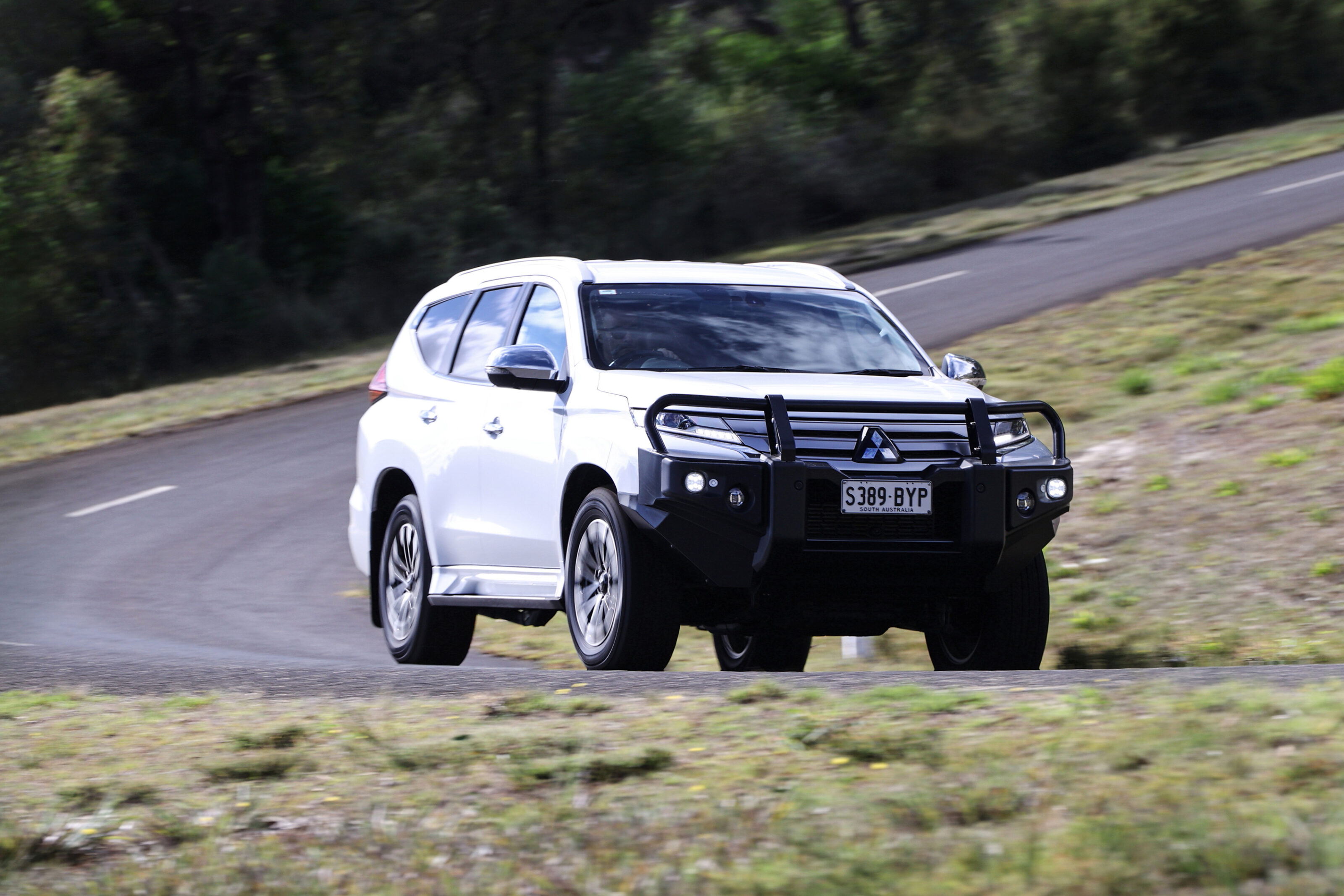Score breakdown
Things we like
- Strong value proposition
- Rugged off-road ability
- Seven-seat practicality
Not so much
- Agricultural on-road behaviour
- Third row access
- Noisy diesel engine
Aussies are not only addicted to dual-cab utes but they’re pretty fond of the large SUVs they spawn, too. Beasts like the Mitsubishi Pajero Sport.
It only takes a cursory glance at the Pajero Sport’s imposing front end to see the close relationship between it and the Triton, but it’s not simply a case of dumping a wagon body on ute underpinnings.
The Pajero Sport replaces the Triton’s leaf-sprung rear end with more sophisticated coils, shortens the wheelbase by 200mm for greater agility, adds an eight-speed gearbox for better performance and fuel economy as well as adding seven-seat functionality while theoretically retaining the ruggedness and off-road capability of its utilitarian sibling.

Four variants are available: the base five-seat GLX, mid-spec seven-seat GLS, fancier GLS Deluxe and our range-topping Exceed test car. Recommended retail price is $57,690 before on-roads but the current drive-away offer is $60,990 based on Victorian registration – check out Mitsubishi’s website for your local pricing.
All variants come with Mitsubishi’s industry-leading 10-year/200,000km warranty, though bear in mind if you don’t have the vehicle serviced at an official dealer that offering halves, while Mitsubishi’s capped-price servicing schedule lasts up to 10 years/150,000km, with services required every 12 months or 15,000km. Servicing costs a total of $5990 over that period with individual services costing between $399 and $999.
The Pajero Sport was launched in 2015 to replace the Challenger but it received an update in early 2020 so, checking out what’s changed, Mitsubishi’s tagline for the update was ‘elevate your journey’ but it probably should’ve been ‘elevate your tailgate’ as the fifth door has received some upgrades.

Room is plentiful in all three rows, though access to the rearmost seats can be difficult
The tailgate is powered (except for GLX) and can now be opened in a number of different ways, including a hands-free kicking motion, using an Apple smartwatch or just by proximity when using the new Mitsubishi smartphone app (latter two Exceed only). This allows a timer to be set and the tailgate will open or close automatically depending on whether you’re approaching or departing the vehicle.
Mitsubishi’s app also allows the tailgate to be set to an intermediate height, displays all manner of vehicle information, alerts the driver if doors have been unlocked, the lights left on or windows left open and can even remotely turn the lights on if you’re looking for the car in a dark parking area. Handy.
Every Pajero Sport comes well equipped with climate control, seven airbags, an 8.0-inch touchscreen infotainment system with smartphone mirroring and digital radio, keyless entry and start, LED daytime running lights, rear vents and USB ports, a 220-volt outlet, adaptive cruise control, forward collision mitigation, rear parking sensors and camera, and trailer stability assist as well as Mitsubishi’s Super Select 4WD-II system.

The GLS adds a rear diff lock, privacy glass, the power tailgate, an extra two speakers for a total of six, integrated sat-nav, third-row seating and auto wipers and headlights. Stepping up to our Exceed test car brings the app functionality, leather seats – with the fronts heated and powered – plus an 8.0-inch digital instrument display, premium eight-speaker audio system, front parking sensors, blind-spot monitoring, lane-change assist, rear cross-traffic alert and the multi-around monitor, which uses the parking cameras to alert of any hidden obstacles you might hit, a handy feature on- and off-road.
It’s very well equipped and the interior has also had a few tweaks, including revised front console and door grip shapes with extra soft pads added and relocation of the power outlet to the rear of the floor console, which has been redesigned for more storage and to be accessible from both sides.
Interior quality isn’t mind-blowing but it’s more than habitable, with comfy seats, easily identifiable and accessible buttons and clever touches like the fact the frequently-used tailgate button is located in the centre of the dash rather than in some obscure hidden location. The Exceed’s digital instruments, which includes the speedometer, tachometer, speed limit display and other vehicle information, is a nice touch, too – quite fancy.

Room is plentiful in all three rows, assuming that only kids will occupy seats six and seven. However, access to the third row is difficult as the centre row doesn’t slide forward and the fact that both cupholders sit on one side is surely almost guaranteed to start arguments. Nevertheless, it’s a roomy and functional cabin, though luggage volume trails its rivals, with 131 litres of space with all three rows in place, 502L with two rows in place and 1488L with all seats folded.
Maximum towing capacity is 3100kg braked or 750kg braked, though the Exceed’s extra toys increase its kerb weight to 2105kg and subsequently limit its payload to 670kg, or 360kg when towing at maximum capacity (compared to 420kg for the base GLX for example).
Off-road capability is a Pajero Sport strength and while you should check out 4×4 Australia’s review for a detailed rundown of its off-piste performance, so unless you’re a hardcore enthusiast you’re likely to be well catered for. Mitsubishi’s Super Select 4WD system offers rear-wheel drive, the handy ability to operate on-road in all-wheel drive and high- and low-range all-wheel drive with a locked centre diff for the rough stuff, as well as a rear diff lock. In addition, there are driving modes for gravel, mud/snow, sand and rock as well as hill descent control.

Mitsubishi says “off-road capability shouldn’t come at the expense of comfort and convenience” but in this case it most definitely does. The 2.4-litre turbo-diesel performs well enough. It’s quite vocal at higher revs but has enough grunt for most situations and the eight-speed gearbox makes good use of it, though our test figure of 11.3sec from 0-100km/h is certainly nothing to sing about.
A word of praise for the paddle shifters, which are lifted directly from the old Lancer Evolution X. It might sound silly, but it’s a welcome bit of fun. Fuel consumption is claimed to be 8.0L/100km and we averaged 8.6L over the course of our loan, though of course the actual figure will vary massively depending on your use and driving style.
Around town the Pajero Sport is quite manoeuvrable, its shorter wheelbase cutting its turning circle to 11.2m whereas its competitors are 11.6-11.8m, but from here it starts to struggle. The car’s dual-cab origins are all-too-obvious in its ride comfort, or lack of.

At low speeds, it’s constantly fidgeting on the road whereas at higher speeds the lack of body control has it lurching and bouncing over bigger bumps. The steering constantly shimmies in your hands, too, which gives the impression of a disconcerting lack of stability.
By the standards of the segment, the Pajero Sport actually steers and handles reasonably well – though it’s not a patch on a Ford Everest – but this is a very low bar indeed, so whether it’s a vehicle to recommend depends entirely on your use case.
If you’re intending to use the Pajero Sport’s undoubted off-road ability on a regular basis then it’s definitely worth a look as it’s practical and good value, though if you can do without some of the toys and the final row the base GLX is a bargain at $47,490 drive-away.
On the other hand, if you just want roomy, dependable family transport then look elsewhere, as the road manners of any decent car-based SUV is simply leagues ahead of anything in this segment. Check out the Hyundai Santa Fe, Kia Sorento, Mazda CX-8/CX-9, Skoda Kodiaq or Toyota Kluger.
Score breakdown
Things we like
- Strong value proposition
- Rugged off-road ability
- Seven-seat practicality
Not so much
- Agricultural on-road behaviour
- Third row access
- Noisy diesel engine






